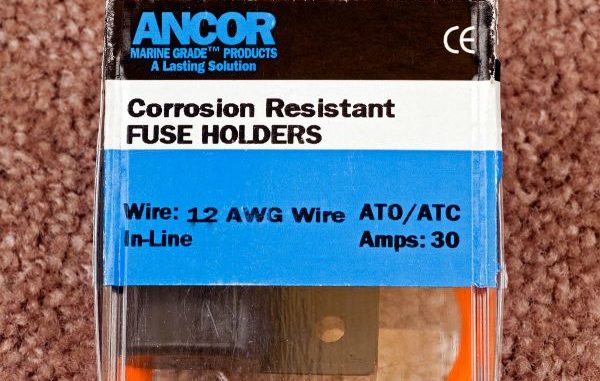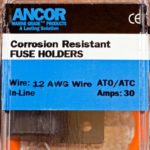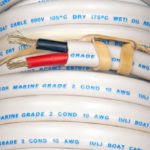
Owning a boat long enough to pay it off has a dark side. I usually own a fishing boat about 15 years — long enough to get it set up just right for me and, unfortunately, long enough to see electrical problems develop.
Sometime during that second decade of ownership, troubles seep into the factory electrical system, and the wiring and accessories I added during the “making it just right for me” process.
Loose, broken and corroded connections must be found; worn, cracked or abraded wire insulation needs fixing (or the wires replaced); and loose or broken wire bundling clamps and straps must be replaced.
Malfunctioning components like switches and circuit breakers also have to go.
There was a time when I thought “marine grade” meant nothing more than an excuse for manufacturers to add a zero to the end of the price tags on electrical parts for boat repairs.
So, trying to save money and not knowing any better, I fixed things with hardware-store or automotive-grade wire, splices, terminals, circuit breakers and fuse holders, and went on my merry way.
I occasionally stumbled across some marine-grade components and added them to the mix, but they remained in the minority.
I found myself having to repeat repairs after just a season or two, and it finally dawned on me that the repetitive problems were coming from fixes done with automotive components. I did some in-depth research on marine-grade electrical parts and quickly discovered not only why they cost more but why they are worth it.
Marine-grade switches are made with corrosion-resistant components and then sealed well enough to survive in a saltwater environment. They should last even longer on a freshwater boat.
And, they resist damage from shock, vibration, UV rays, fuel and oil.
Automotive switches, on the other hand, are designed to work inside a weatherproof vehicle with a relatively soft ride, and they seldom survive getting wet.
Marine-grade circuit breakers are waterproof, and marine fuse holders are at least splash-resistant. Marine fuse and common ground panels use heavy copper bus strips mounted solidly enough on insulated backing plates to resist damage from corrosion and survive a lifetime of rough water pounding.
Sealed marine-grade electrical components can’t spark and are safer to use in enclosed bilge, and engine and battery compartments.
Automotive-grade wire has no place on a boat. The insulation on some of it is not resistant to much in the marine environment and can literally crumble off over time, leaving bare wire exposed.
And once corrosion gets under the insulation at a terminal end, it can spread through the entire length of a wire’s copper strands.
Ancor Marine Grade Products is part of Power Products, and it is perhaps the most-prolific manufacturer of quality marine-grade wire, terminal components and wire-working tools.
Ancor marine wire is type 3 stranded, meaning that is has five to 10 times more copper strands than type 2 wire, and each strand is pre-tinned to resist corrosion.
It is made to American Wire Gauge rather than automotive SAE standards, which makes it 6 to 12 percent larger and therefore able to carry a given amount of current with less heat.
It also comes sheathed in thicker insulation that is resistant to UV, gas, oil, acids and other marine hazards, and in colors that conform to the marine color code.
Marine-grade butt splices and terminal ends also differ from their automotive counterparts. Ancor makes marine shrink connectors sheathed in cross-linked polyolefin tubing that will not burn and is stronger than the usual PVC tubing. Protruding ends of the insulation on these connectors can shrink to a third of their original size when heated to seal the connection and provide strain relief.
Shrink connectors are available with a heat-activated adhesive lining that flows when hot and seals the connector to the wire as it cools. These are especially effective in areas like the bilge, where connections are routinely submerged in water and exposed to gas, oil and acids.
Ancor’s marine-grade connectors use a pure copper core tinned to resist corrosion, and covered with a nylon insulator that resists vibration and accidental cuts during crimping.
Marine-grade shrink tubing from Ancor is also made of adhesive-lined cross-linked polyolefin tubing that can shrink to a third its original size. Shrink tubing can be used to seal connections made with non-shrinking butt connectors and terminal ends or to add an additional layer of waterproof strain relief to any connection. It can also serve as a chafing pad where wire runs pass through bulkheads.
Motion from shock and vibration as boats pound over rough water and trailer over pot-holed roads is also a trouble maker for wire connections. Stabilizing them with clamps and wire ties keeps motion to a minimum.
Clamps and plastic wire bundling ties are available in several grades. Marine-grade versions are best, but those from local building supply centers labeled as having extra UV protection (usually black in color) will also last longer on your boat than standard, cheap plastic ties and clamps.
Finding a local source for marine-grade components can be difficult. Some marine dealerships and sporting goods stores sell automotive-grade electrical supplies, so look closely before you buy.
Nationwide boating outlets like West Marine (westmarine.com) and Boaters World (boatersworld.com) carry some marine-grade components, as do sporting goods outlets like Bass Pro Shops (basspro.com) and Cabelas (cabelas.com). You can order online, shop catalogs or visit local stores if you are lucky enough to have one in your area.




